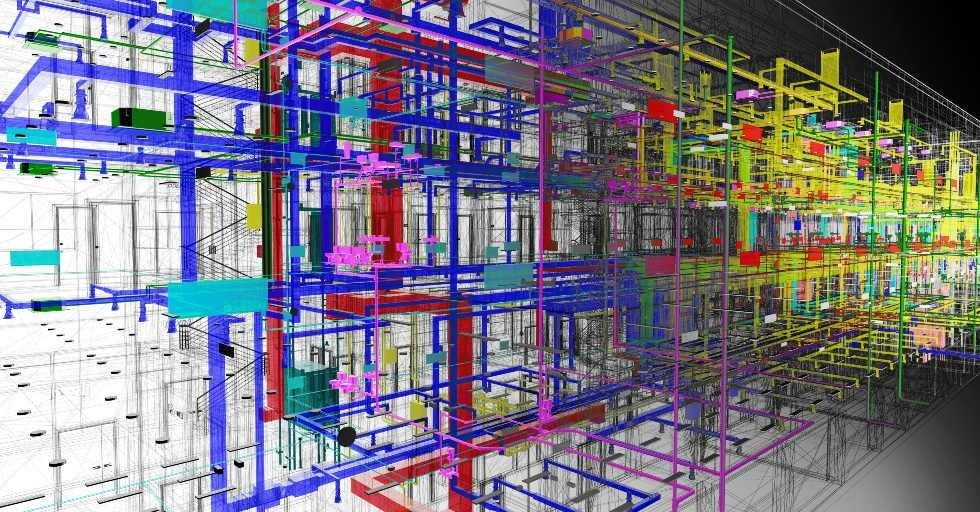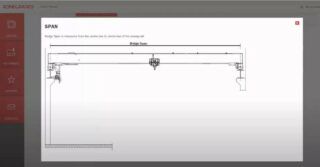Construction is becoming increasingly complex around the world, with new technologies and processes aimed at improving project efficiency and productivity. One of the most significant achievements in recent years has been the development of Building Information Modelling (BIM), which is changing the way we design.
In today’s world, everything is a virtual object before it is built, even in the case of physical buildings, where the construction process is supported by various tools, technologies and digital techniques.
What is BIM (Building Information Modeling), and why should we consider this software?
BIM is a technology for creating and managing building projects using their virtual models. These virtual models help architects and engineers visualise the structure to identify potential design, construction or operational issues.
The software enables the creation of detailed 3D models filled with data about the physical object. Designers, architects and contractors collaborate on these models, refining projects and resolving potential issues before construction begins, resulting in more efficient and error-free construction.
The software is used by individuals and companies planning the construction and maintenance of a wide range of infrastructure, including water, electricity and gas utilities, roads, railways, bridges, ports and even tunnels.
It’s worth noting that BIM has existed and evolved alongside computer-aided design (CAD) for over 35 years. Today’s BIM encompasses more than just geometry; it includes spatial relationships, geospatial information, confidence building, asset management, sustainable development, manufacturing details and much more
These features allow users to extract different views from building models. Professionals such as architects, surveyors, civil engineers and structural engineers typically use them to share information. Each engineer adds specific data from his or her discipline to a common model that integrates several different disciplines into one. The combination of all these disciplines then allows the object to be visualised. All the models exist in one environment, promoting better coordination and streamlining the project, and ultimately aiding decision making.
In the past, before such programmes were available, large projects often encountered problems that could probably have been avoided with BIM-type software.
➡ Completed in 1973, the world-famous Sydney Opera House could have benefited from Building Information Modelling (BIM). Although it was one of the first major projects to use computer analysis to design its iconic roof shells, it was also controversial for the way it was designed.
The government at the time required construction to start before final project approval, which meant that many construction challenges had to be tackled without finalised plans. This led to several delays and problems. During construction it became apparent that the concrete podium columns designed to support the main structure were not strong enough and had to be completely replaced. Costly changes were also made to the roof shell, resulting in several schedule changes. While the final result was spectacular, the use of building modelling technology would have allowed the design team to finalise plans for columns and roof shells long before construction began.
➡ Another example is the Citigroup Center in New York, a 279-metre skyscraper built in 1977. A year after completion, it was discovered that the chief engineer, William LeMessurier, had failed to include certain wind forces in his calculations. In addition, bolted joints were used in the structure to save on construction costs. As a result of these oversights, the building became structurally unstable and threatened to collapse during a hurricane. Estimates at the time suggested that the building could be toppled by winds of 110km/h.
The discovery was made in 1978 and a three-month emergency repair averted a potential disaster. Such a problem could have been avoided. Engineers and contractors could have worked together better to select connections and carry out accurate wind load simulations during the design phase. Information about this problem was kept secret until 1995.
➡ Another example is Berlin Brandenburg Airport. Construction began in 2006 and is scheduled for completion in 2020. The airport has been delayed for many years and is billions of euros over budget.
The main cause was numerous design flaws. Some analyses suggest that over half a million defects were identified during construction as a result of mismatched escalators.
The short history of the BIM software
The first tool developed for building modelling was introduced in the 1970s by Chuck Eastman, a professor and pioneer in the field of design cognition and building information modelling (BIM). Eastman, later dubbed the “father of BIM”, advocated a computer-based alternative to traditional drawings for construction documentation. The system for manipulating project information was initially called BDS (Buildings Description System). It included a graphical user interface, isometric and perspective views, and a sortable database that allowed users to search for information by categories such as material type and supplier. Eastman claimed that this solution could reduce project costs by up to 50%, criticising traditional drawings for their inefficiency and inability to accurately represent buildings.
Despite their historical significance, Rucaps, Sonata and Reflex are less well known today. All three systems played a fundamental role in the development of current BIM technology and were largely led by Australian Jonathan Ingram. In 1986, Ingram released Sonata, the first system to combine modern BIM features in one application, allowing users to create a single building model in one file. Sonata, possibly the world’s first BIM-supporting application, was recognised with awards from Prince Philip and the British Computer Society. After several years, Sonata evolved into the more user-friendly Reflex, which was sold to PTC in 1996. PTC was a prominent company known for its Pro/Engineer application, which later became Creo.
ArchiCAD, the first commercial PC-based BIM product, was released in 1987 by Hungarian company Graphisoft. ArchiCAD was considered revolutionary for its ability to store large amounts of information, allowing users to create virtual buildings with elements such as walls, floors, roofs, doors, windows and furniture. It leapfrogged the competition and quickly became a worldwide success. The first Windows version of ArchiCAD was released in 1995.
Before 1990, licensing costs for pre-1990s building modelling applications such as ArchiCAD, Sonata or Catia were prohibitive. The software required advanced workstations that were expensive and therefore inaccessible to the general public.
In 1998, two PTC employees left to start their own company focused on developing a building modelling application called Revit, which was later acquired by Autodesk in 2002. Autodesk also published a white paper on Building Information Modelling in the same year. It’s worth noting that BIM wasn’t widely used until the early 21st century.
Previously, BIM adoption had progressed at different rates in different countries. One challenge during these years was the existence of different standards in each country, which led to communication problems between projects. To address this, a new international standard for managing information throughout the lifecycle of a building has been developed – ISO 19650. This standard, based on the well-established British Standard BS 1192, aimed to bridge the gap between the different standards that existed in different countries.
History in a nutshell: The history of Building Information Modelling (BIM) software is marked by significant milestones and the continuous evolution of the technology.
Here’s a chronological overview:
Chuck Eastman’s BDS (Buildings Description System):
Timeframe: 1970s
Significance: Chuck Eastman, a professor and pioneer in design cognition, introduced the first building modelling tool. His system, BDS, laid the foundation for computer-based alternatives to traditional drawings for construction documentation.
Rucaps, Sonata and Reflex:
Timeframe: 1980s
Significance: Australian Jonathan Ingram played a key role in the development of three systems – Rucaps, Sonata and Reflex. Sonata, released in 1986, was one of the first applications to combine modern BIM features in one application. Reflex, a more user-friendly programme, was sold to PTC in 1996.
ArchiCAD:
Timeframe: 1987
Significance: ArchiCAD, developed by Hungarian company Graphisoft, was the first commercial PC-based BIM product. It was revolutionary in its ability to store large amounts of information and quickly gained worldwide recognition.
Revit:
Timeframe: 1998
Significance: Two PTC employees left to start their own company, which developed Revit, a building modelling application. Autodesk acquired Revit in 2002 and it became a major player in the BIM software market.
ISO 19650 standard:
Timeframe: 2019
Significance: The ISO 19650 standard was developed to address the challenge of different standards in different countries. It is an international standard for managing information throughout the lifecycle of a building.
Throughout this history, BIM software has evolved from early systems such as BDS to sophisticated applications such as Revit, ArchiCAD and others. These software solutions have helped to improve collaboration, reduce errors and increase overall efficiency in the Architecture, Engineering and Construction (AEC) industry. As technology continues to advance, the capabilities of BIM software are expected to grow, enabling more complex and integrated building design and construction processes.
Summary
With BIM-based design, issues such as mismatched pipe segments are addressed in the model, preventing them from becoming actual errors. Although such errors can lead to delays, unexpected costs and significant stress for all involved, they have allowed the industry to learn lessons and ensure better practices in the future.
As for the BIM world itself, technology, processes and skills are constantly evolving, leading to more projects pushing the boundaries. What is now possible with BIM is far more advanced than what was possible at the start of the software’s journey, and its continued evolution will undoubtedly lead to more complex projects in the future.
The benefits of BIM in construction include:
- Integration of information: BIM enables all relevant project information to be gathered in one place, making it easier for all parties to access and manage data.
- 3D building visualisation: BIM enables the creation of a three-dimensional model of the building, improving understanding of the project and identifying potential problems before construction begins.
- Interdisciplinary coordination: with BIM, the various departments involved in the project (architects, engineers, installation designers) can work together more efficiently, helping to avoid errors.
- Cost management: BIM enables better cost forecasting by providing more accurate estimates of the materials and labour required to complete the project.
- Sustainable development: by incorporating data on energy consumption, materials and other environmental factors, BIM can support a sustainable approach to design and construction.
- Facilitate asset management and maintenance: BIM provides information on the maintenance and operation of the building, making it easier to manage and maintain.








